Transactional email vs. marketing email serve different purposes, and they also perform differently in terms of deliverability and engagement. Transactional emails are messages sent automatically after a user takes an action. This includes emails like order confirmation, password reset, or delivery update. Since users expect these emails, they usually open them quickly. They have high deliverability because email service providers see them as important. They also receive more attention, with more people opening and clicking on them.
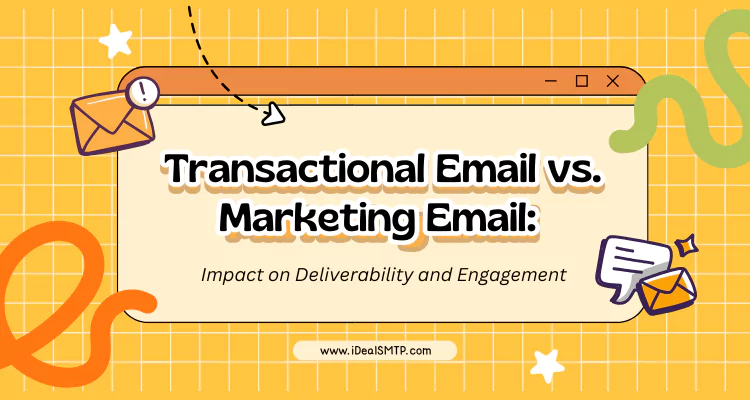
Marketing emails are used to share promotions, offers, or updates about products or services. These include newsletters, offers, and product announcements. While they can be helpful, they are not always expected by users. If sent too often or to the wrong audience, they might end up in the spam folder. This can lower deliverability and reduce engagement. To get the best results, businesses should clearly separate these two types of emails. Use a reliable SMTP service provider for transactional emails and a smart email strategy for marketing emails. This helps improve trust, inbox delivery, and customer response. In this blog we will cover the main difference between Transactional Email vs. Marketing Email.
Table of Contents
What is Transactional Email?
Transactional emails are messages that are automatically sent when someone does something on a website or app. These emails are not used for marketing or promotions, they are sent to give important information that the user needs.
For example, when you place an order online, you receive an order confirmation email. If you forget your password and click on “reset password,” an email will be sent to help you create a new one. These are both examples of transactional emails.
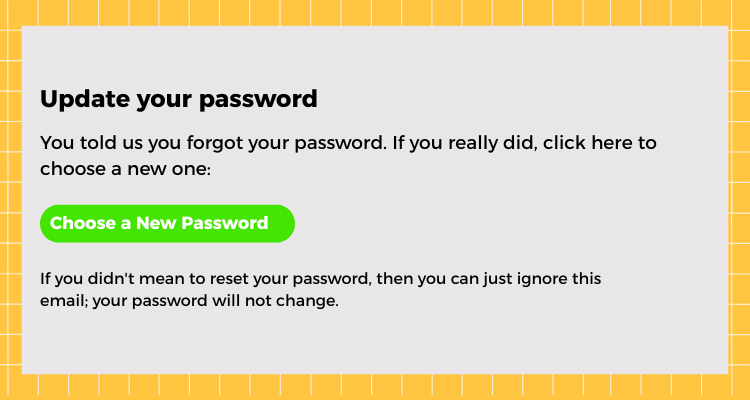
Other common types include shipping updates, account creation emails, invoice receipts, and login alerts. People expect these emails, so they usually open them quickly. That’s why open rates and deliverability are much better for transactional emails than for marketing emails.
Transactional emails are sent individually and are triggered when a user takes a specific action. They are important for building trust and providing a smooth customer experience. If these emails don’t arrive on time, it can lead to confusion or a bad experience.
To make sure these emails reach the inbox, businesses often use SMTP email services or transactional email APIs. These tools help send emails fast, securely, and without delay.
What is Marketing Email?
A marketing email is a message sent to promote a business, product, service, or special offer. The goal of a marketing email is to attract attention, increase sales, or build a relationship with customers. These emails are usually sent to a list of people who have signed up to receive updates or offers.

Common types of marketing emails include newsletters, promotional offers, product launches, event invitations, and special discounts. Businesses use these emails to stay connected with customers, share news, and encourage people to take action, like buying a product or visiting a website.
Marketing emails are different from transactional emails because they are not sent based on a user’s action. They are planned and sent as part of a marketing strategy. To be successful, marketing emails should have a clear message, attractive design, and strong call-to-action (CTA).
It is important to follow email marketing rules, such as getting permission before sending emails and giving users the option to unsubscribe. This keeps your sender reputation strong and improves email deliverability.
Difference Between Marketing Email vs Transactional Email
Understanding the marketing vs transactional email is important for any business. Here are the main differences between Transactional Email vs. Marketing Email in simple points:
Purpose:
- Transactional emails are sent when a user takes an action, like making a purchase or signing up.
- Marketing Emails are sent to promote a product, service, or offer.
Content Type:
- Transactional Emails contain important information like order details, login alerts, or password reset links.
- Marketing Emails include promotional messages, discounts, and newsletters.
User Expectation:
- Users expect transactional emails after doing an action.
- Marketing emails are not always expected and may be ignored.
Permission:
- Transactional Emails don’t need user permission because they’re based on a user’s action.
- Marketing Emails require permission (opt-in or subscription).
Open Rate:
- Transactional Emails have higher open rates.
- Marketing Emails often have lower open rates.
Spam Risk:
- Transactional Emails rarely go to spam.
- Marketing Emails can go to spam if not done correctly.
How to Set Up and Send Transactional Emails
Sending transactional emails becomes simple when you follow the correct steps. These emails are sent automatically after a user takes an action, like signing up or placing an order. Here’s how you can set them up:
- Choose an SMTP or Email Service Provider: Pick a reliable SMTP Service Provider and Email Service Provider like DigitalAka, SMTPmart, SendGrid, iDealSMTP or Mailgun to send your emails quickly and safely.
- Connect Your Website or App: Link your website or app to the email marketing service using SMTP or API. This allows the system to send an email after an action is completed.
- Create Email Templates: Design simple templates for common actions like welcome emails, password resets, or order confirmations.
- Add Dynamic Content: Use user data (like name, order ID, etc.) to personalize the emails automatically.
- Test Your Emails: Before going live, test emails to check how they look and whether they land in the inbox.
- Monitor Delivery Reports: Track delivery, open, and bounce rates to make sure your emails are working properly.
How to Set Up and Send Marketing Emails
Marketing emails help promote your business, products, or services. Here’s a simple step-by-step guide to set up and send marketing emails:
- Choose an Email Marketing Tool- Use Bulk Email Marketing platforms like iDealSMTP, Mailjet, SMTPmart or Sendinblue to send bulk emails easily.
- Create an Email List- Collect email addresses from people who want to hear from you. Use sign-up forms or landing pages.
- Segment Your Audience- Group your contacts based on their interest, location, or buying history. This helps send targeted emails.
- Design Your Email- Use a clear subject line, simple layout, images, and a strong call-to-action (CTA). Make it mobile-friendly.
- Write Engaging Content- Keep your message short, friendly, and focused. Highlight offers, news, or updates clearly.
- Follow Email Rules- Add an unsubscribe link and your company’s address to follow anti-spam laws like GDPR and CAN-SPAM.
- Send a Test Email- Check your email on mobile and desktop before sending it to everyone.
- Schedule and Send- Pick the best time to send your email. Early mornings and mid-week work well.
- Track Performance- Check open rates, click rates, and replies to improve future campaigns.
Using SMTP Mail Servers to Boost Your Email Reputation: Marketing vs Transactional Emails
Sending transactional emails the right way is important to make sure your messages reach your users quickly and safely. These emails include things like order confirmations, password reset links, and updates about your account. Here’s how you can send Transactional Email vs. Marketing Email step-by-step:
- Choose a Reliable SMTP or Email API Provider- Pick a trusted SMTP mail service like iDealsmtp, SMTPmart, SendGrid, or Mailgun. These Bulk email services are designed to send transactional emails quickly and ensure high delivery rates.
- Design Your Email Template- Keep it clean and easy to read. Focus on the message, such as order details or login links. Avoid using too many images or making your content too promotional.
- Set Up Authentication- Make sure your domain has SPF, DKIM, and DMARC records. This creates trust and increases the chances of your email reaching the inbox instead of the spam folder.
- Connect Your App or Website- Use SMTP settings or an API to link your website or app with your email provider. This helps send emails automatically when a user takes action.
- Test Your Emails- Before going live, send test emails to check how they look and if they land in the inbox.
- Monitor Email Performance- Monitor email opens, delivery results, and bounce rates. This helps improve your future emails.
5 Best Marketing vs Transactional Email Service Provider
Choosing the right email service provider depends on what kind of emails you want to send, marketing emails, transactional emails, or both. Here are 7 of the best Transactional Email vs. Marketing Email providers and how they support each type:
1. iDealSMTP:
iDealSMTP is a Bulk email service provider that makes it easy for businesses to send bulk emails, transactional messages, and marketing campaigns. It offers a fast and secure SMTP server to make sure your emails reach your customers’ inbox without delay.
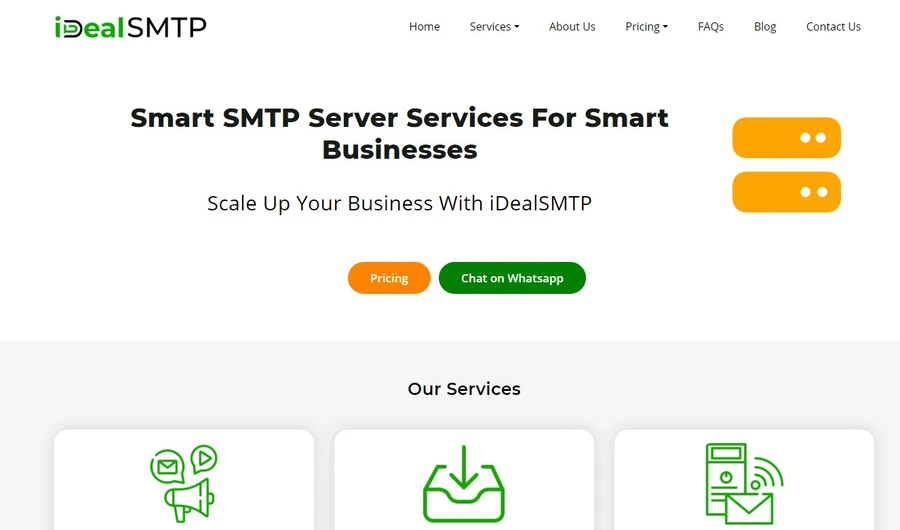
With iDealSMTP, you can send emails like order confirmations, password resets, newsletters, and promotional offers. It is easy to set up and works well with most websites, apps, and email tools.
One of the best things about iDealSMTP is its high email deliverability rate, which means fewer emails go to spam folders. It also provides real-time reports, allowing you to see how many people opened or clicked on your emails.
Whether you’re a small business or a large company, iDealSMTP offers affordable plans and good support to meet your email needs.
Features Provided by iDealSMTP:
Here are the key features offered by iDealSMTP:
- Reliable SMTP Server- Send emails fast and securely through a trusted SMTP server.
- High Deliverability- Makes sure your emails land in the inbox instead of the spam folder.
- Transactional Email Support- Send order updates, password resets, and account alerts with ease.
- Bulk Email Sending- Quickly send thousands of marketing emails or newsletters at once with ease.
- Real-Time Email Tracking- Track opens, clicks, bounces, and delivery reports instantly.
- Easy Integration- Works smoothly with websites, apps, and email platforms.
- API Access- Developers can use APIs to automate email sending from apps or systems.
- Email Scheduling- Schedule your email campaigns to go out at the most effective time.
- Dedicated IP Option- Get your own IP address for better control and sending reputation.
- 24/7 Customer Support- Our friendly support team is always here whenever you need help.
2. SendGrid-
SendGrid is a well-known email service that helps businesses send marketing emails and transactional messages easily and reliably. It is trusted by companies of all sizes because of its high email deliverability and easy-to-use tools.
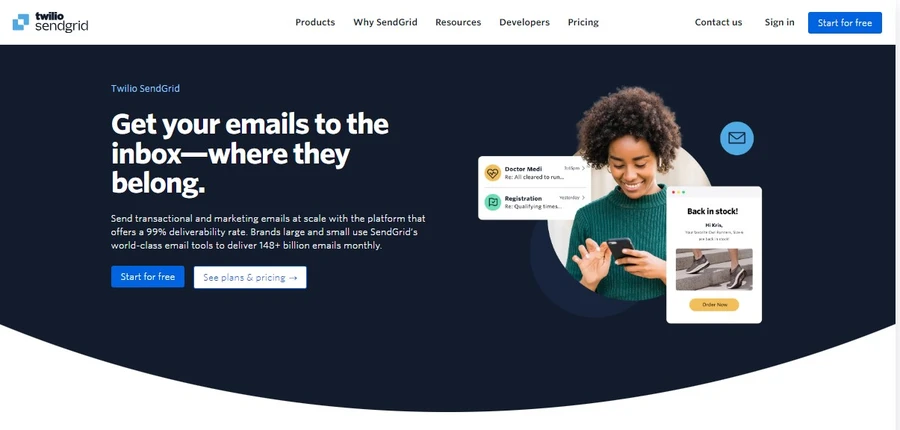
SendGrid makes marketing emails easy with its drag-and-drop editor, ready-to-use templates, and detailed analytics. You can quickly design newsletters, promotional messages, and product update emails. It also helps you manage your contact lists and follow email rules like CAN-SPAM.
For transactional emails, SendGrid provides strong API support. You can send order confirmations, password resets, and alerts in real-time. These emails are delivered fast and safely to the user’s inbox.
SendGrid also helps improve email security and inbox delivery by supporting email authentication methods like SPF and DKIM. Whether you’re a developer or a marketer, SendGrid gives you the tools to manage emails smoothly.
Features Provided by SendGrid-
Here are some important features that SendGrid provides for managing and sending emails:
- Email API- Easy integration to send transactional emails like order updates, login alerts, and password resets.
- Marketing Campaigns- Drag-and-drop email editor for creating promotional emails and newsletters.
- High Deliverability- Trusted by inbox providers, helping your emails land in the inbox instead of the spam folder.
- Email Templates- Pre-designed and fully customizable templates for both marketing and transactional emails.
- List Management- Tools that help you organize and segment your subscriber lists with ease.
- Analytics and Reports- Monitor email performance by tracking opens, clicks, bounces, and other key metrics.
3. SMTPmart-
SMTPmart is an email service provider that helps businesses send bulk emails and transactional messages easily. It offers a fast and secure SMTP server that makes sure your emails reach the inbox without delays. Whether you want to send newsletters, offers, alerts, or order confirmations, SMTPmart can handle it all.
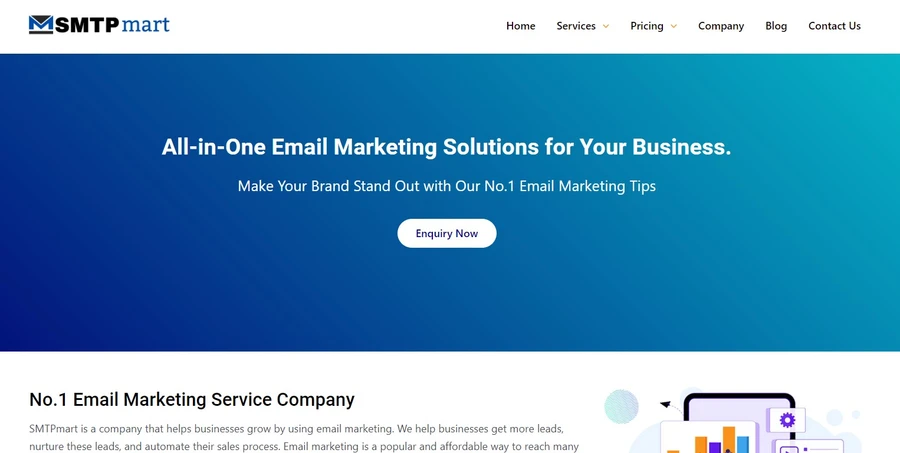
This service is easy to use and works well for both small and large businesses. You can use it for marketing emails as well as important transactional emails like password resets or shipping updates. SMTPmart also provides helpful features like real-time tracking, detailed reports, and 24/7 support.
With SMTPmart, you don’t have to worry about your emails going to spam. It follows email best practices and offers high deliverability. If you’re looking for a simple, affordable, and reliable bulk email service, SMTPmart is a great choice for your email marketing and business communication needs.
Features provided by SMTPmart:
Here are some features provided by SMTPmart:
- Fast Email Delivery- Send emails quickly so your users get messages on time.
- High Inbox Deliverability- Make sure your emails go to the inbox, not the spam folder.
- Supports Bulk Email Sending- Easily send thousands of emails for promotions, offers, or updates.
- Transactional Email Support- Send automatic emails like order updates, login alerts, or password resets.
- 24/7 Customer Support- Get help anytime with setup, sending, or technical issues.
- Easy SMTP Integration- Works smoothly with websites, CRMs, or email tools using SMTP.
- Real-Time Reports- Track opens, clicks, bounces, and email status in real-time.
- Secure & Trusted Sending- Uses email authentication (SPF, DKIM, DMARC) for safe sending.
- Affordable Plans- Offers budget-friendly pricing for startups, small businesses, and large companies.
- User-Friendly Dashboard- Simple and clean interface to manage all your email campaigns.
4. Mailjet-
Mailjet is a well-known email service provider that lets you send both marketing and transactional emails easily. It is perfect for businesses that want to connect with customers through emails like newsletters, promotions, or order updates.
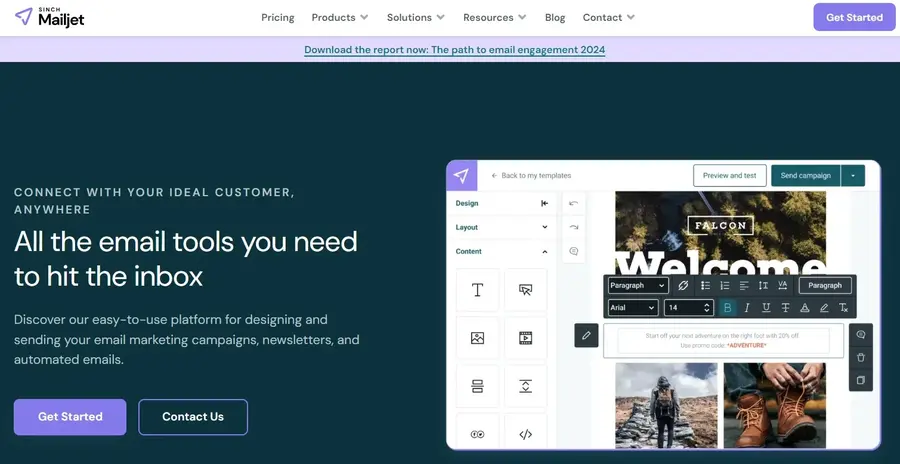
With Mailjet, you can easily design your emails using its drag-and-drop editor, even if you don’t know coding. It also allows you to send automated emails like welcome messages or shipping confirmations. You can manage your contact lists, track email opens and clicks, and improve your campaigns.
Mailjet also supports SMTP and API integration, which means you can connect it with your website or app to send emails automatically.
It offers good email deliverability, so your messages reach the inbox, not the spam folder. Whether you’re a small business or a growing company, Mailjet gives you the tools to send emails easily and grow your audience.
Features provided by Mailjet:
Here are some features provided by Mailjet:
- Email Marketing- Create and send newsletters, promotions, and offers easily.
- Drag-and-Drop Email Builder- No coding needed. Just drag and drop to design beautiful emails.
- Transactional Email Support- Send important emails like order updates, password resets, and confirmations.
- SMTP and API Integration- Link Mailjet with your website or app to send emails automatically whenever needed.
- Email Automation- Set up automatic emails like welcome messages or birthday wishes.
- Contact List Management- Organize your email lists, add tags, and manage subscribers easily.
5. Elastic Email-
Elastic Email is an easy-to-use email service provider that helps businesses send both marketing and transactional emails. It is known for its affordable pricing and user-friendly features. With Elastic Email, you can send newsletters, promotions, order confirmations, and more.
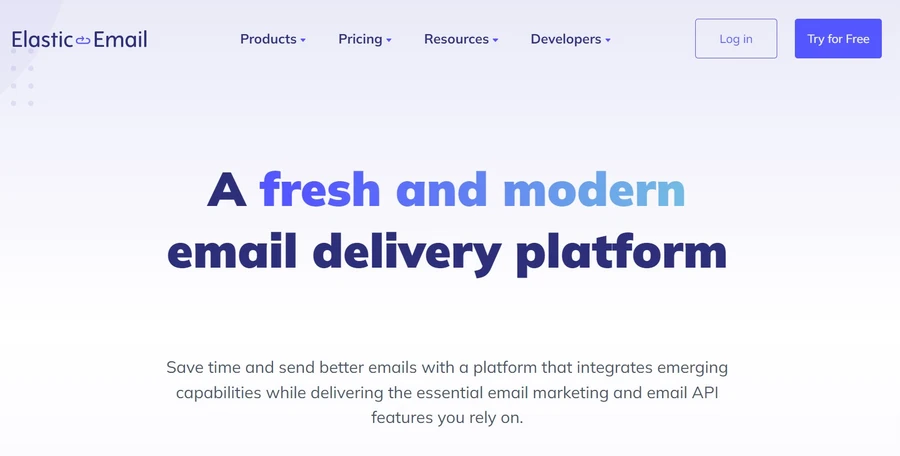
It offers a simple drag-and-drop editor for designing emails and a powerful API for developers to send emails directly from websites or apps. You can manage your contact lists, track email performance, and improve your open rates with detailed reports.
Elastic Email also supports SMTP relay, which makes sending transactional emails fast and reliable. Whether you’re a beginner or a developer, it offers tools to match your needs.
With strong inbox delivery, good customer support, and low-cost plans, Elastic Email is a smart choice for small businesses, startups, and marketers who want to send bulk or automated emails without spending too much.
Features Provided by Elastic Email-
Here are some of the key features offered by Elastic Email:
- Email Marketing Campaigns- Create and send newsletters, promotions, and bulk emails easily.
- Drag-and-Drop Email Editor- Design professional-looking emails without coding.
- Transactional Email Sending- Send order updates, password resets, and alerts using API or SMTP.
- Powerful Email API- Connect your app or website to send automated emails quickly.
- SMTP Relay Support- Simple setup for sending emails from your system securely.
- Advanced Analytics- Track opens, clicks, bounces, and more to improve results.
- Contact List Management- Add, segment, and manage your subscriber lists with ease.
- Email Scheduling- Plan and schedule emails to go out at the best time.
Conclusion-
Understanding the difference between marketing emails vs transactional emails is important for your email success. Transactional emails are reliable, anticipated by users, and usually get higher deliverability and engagement. Marketing emails, while useful for promotions, need smart planning to avoid being marked as spam. Combining the two can damage your email reputation. Always keep them separate and use the right tools to send each type. This helps your messages reach the inbox, improves customer experience, and builds long-term trust. In short, using both types correctly can boost your communication and support your business growth in a strong and reliable way.
FAQ related to Transactional Email vs. Marketing Email
Here are some common question:
Is it better to use different tools for sending them?
Yes, it’s best to use separate email tools or email marketing services for each type.
Which one is more likely to go to the spam folder?
Marketing emails are more likely to be marked as spam if not done properly.
Can I include promotions in transactional emails?
It’s not recommended. Combining marketing content with transactional emails can lead to problems with email deliverability.
Which email type has better open rates?
Transactional emails usually have better open and click rates because users expect them.
Do marketing emails need permission?
Yes, you must get user permission (opt-in) before sending marketing emails.
Do transactional emails need user permission?
Not always. These emails are expected because the user did something to trigger them.
Are transactional emails the same as marketing emails?
No, they are different. Transactional emails are sent for personal activities or actions, while marketing emails are used to promote products or services.
What is a marketing email?
A marketing email is used to promote products, offers, or updates to a group of people.
What is a transactional email?
A transactional email is sent when a user does something, like placing an order or resetting a password.






